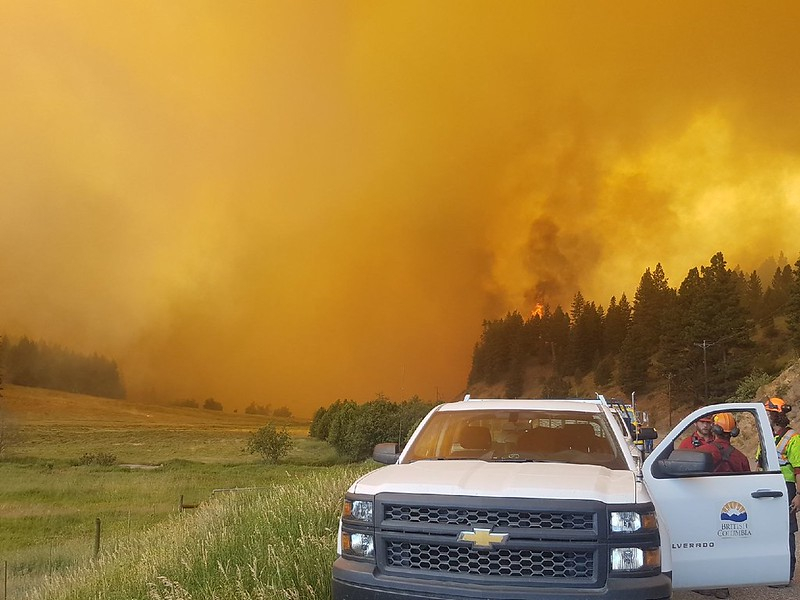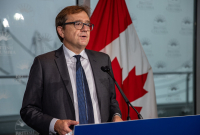Support strong Canadian climate journalism for 2025
For a generation now, governments have played a dangerous, costly game with wildfire in British Columbia. Government must do many things to win this game. It must prevent wildfire outbreaks, put fires out and help communities recover from the aftermath. Unfortunately, wildfire is in first place.
Climate change is the biggest culprit here. It has pushed B.C. across the threshold to a new reality. Wildfires are now more frequent, intense and costly.
But how we manage wildfire also shapes this new reality. Last century’s approach overwhelmingly favoured two ideas: heeding Smokey Bear’s prevention advice and putting out wildfires after they started.
Suppression obviously remains crucial. But climate change literally has changed the wildfire terrain. In B.C., it dries out forest fuel and fosters the spread of the mountain pine beetle. The beetle thrived as winters became warmer, leaving behind millions of hectares of dead-standing timber, an ideal wildfire fuel. As we see here, experts and government studies have championed much greater investment in the prevention and mitigation of wildfires. Governments have not done nearly enough to take this crucial pillar of 21st-century wildfire seriously. The 2024-25 B.C. budget continues this pattern of neglect.
First, let’s recap what this new reality looks like.
B.C.’s new wildfire reality
“Unprecedented” is a common term used to describe B.C.’s recent wildfire history. The charts below confirm what wildfire scientists have told us for years. Climate change magnifies wildfire risks. In 2017, wildfires consumed a record amount of forest; 2018 eclipsed that record. And last year obliterated that record. The wildfires of 2023 more than doubled the area burned in 2018, an area half the size of Nova Scotia.
With respect to costs, last year B.C. taxpayers paid a staggering $1.085 billion to fight wildfires, nearly nine times what was spent a decade earlier.
More dollars in the 2024 B.C. budget, but will it be enough?
B.C.’s February budget set aside $233 million for wildfire management. No B.C. government has ever made a larger initial commitment to fighting wildfires.
But will it be enough? Over the last 10 years, the average annual wildfire-fighting bill has been $498 million, more than twice the amount laid out in the government budget. Contrary to this commitment, the premier warned he’s expecting this fire season to be even worse than the $1.1-billion 2023 season. The government’s budget, in other words, seems to have lowballed what this fire season is likely to cost taxpayers.
Where will Victoria get the money to manage wildfires if costs go above $233 million? The B.C. Wildfire Service says it will use this year’s $3.5-billion general contingency fund to cover any extra firefighting costs. Setting aside funds to pay for anticipated events with uncertain costs like wildfire is a longstanding budget practice. But, this year’s contingency funds dwarf the amounts set aside in the past. Ten years ago, contingency funding was how much? It was less than one-tenth of this budget’s $3.5 billion. Escalating wildfire expenses are a major contributor to this change.
Are the budget’s wildfire priorities still appropriate?
In the history of wildfire management, wildfire response and suppression dominate budgets. The 2024-25 budget is faithful to this pattern.
Most of the budgeted $233 million is earmarked for response or fire suppression. The B.C. Wildfire Service says only about $40 million will fund prevention and wildfire risk reduction work. These are measures such as clearing deadfall and low-lying vegetation. The budget also provides approximately $20 million annually over the next three years to the Forest Enhancement Society of B.C. for wildfire risk reduction and fuel management work.
Climate change and the historical success of suppression call into question the wisdom of a pattern where so few resources are devoted to prevention/mitigation. Climate change and suppression have combined to produce drier, denser, fuel-rich forests. This new reality demands human intervention of a different sort, including forest fuel reduction measures to reduce the flammability of forests close to communities.
Calls for B.C. budgets to devote serious attention and resources are not new. Former Manitoba premier Gary Filmon was called on to investigate B.C.’s disastrous 2003 fire season and concluded forest fuel buildup contributed to the severity of those fires in the B.C. Interior. He recommended B.C. assign a “high priority” to wildfire fuel reduction.
Filmon’s advice fell on deaf ears. Years later, Skawahlook First Nation Chief Maureen Chapman and former MLA George Abbott examined B.C.’s 2017 plague of natural disasters. They discovered a yawning gap between wildfire suppression and prevention expenditures. Between 2003 and 2017, B.C. spent $3.1 billion on fire suppression and a measly $73.8 million on prevention.
Chapman and Abbott also believed there was an urgent need for significant prevention and mitigation funding. They warned: “The challenges of fuel mitigation and community safety will not diminish…Solutions will be neither easy nor inexpensive, but in the absence of substantial new investment, we can expect that the costs of wildfire suppression, and losses to citizens and the provincial economy, will continue to grow.”
Again, the government did not make substantial new investments in prevention and mitigation. For example, the provincially funded Forest Enhancement Society of B.C. (FESBC) was created in 2016 primarily to prevent and mitigate wildfires. To date, however, this commitment has been more symbolic than substantive. Between 2016 and 2020, FESBC spent only 24 per cent of the $238 million it received from B.C. on wildfire risk reduction.
The charts above suggest that, in the absence of those investments, their warning foreshadowed all too well what British Columbians have experienced since then.
The wildfire service’s $40-million fund for wildfire risk reduction this year is minuscule. The government’s lack of seriousness is also confirmed by the three-year commitment of $20 million per year for FESBC. This commitment, if spent solely on fuel management, would only treat the tiniest sliver of land at moderate to high risk of sending embers into B.C. communities during a wildfire.
FESBC’s fuel treatment cost estimates suggest the society could treat just 150 square kilometres of land annually. This is one-half the size of Kamloops and less than one per cent of B.C.’s moderate- to high-risk lands. This might be a sad joke if the potential consequences for people, their communities, and the climate weren’t so devastating.
Front-line wildfire fighters welcome more dollars in this year’s budget for wildfire management. But, some also point to the urgent need to invest seriously in prevention and mitigation. West Kelowna Fire Chief Jason Brolund says that even after last year’s devastating fire, millions and millions of dollars of prevention and mitigation measures could be done there. But, there’s no funding for them. The budget doesn’t invest significantly in this pillar of wildfire management.
What should be done?
The traditional wildfire budget paradigm, where only a fraction of resources was devoted to prevention and mitigation, worked well enough in the 20th century. But climate change demands we bid it farewell. In addition to developing more efficient and effective partnerships to respond to wildfires, we must finally recognize and substantially fund prevention and mitigation measures. Future budgets, of all levels of government, must introduce a new management paradigm to tackle B.C.’s new wildfire reality.
Ian Urquhart is a professor emeritus of political science at the University of Alberta. His teaching and research there focused on the political economy of natural resource exploitation and climate change. His 2018 book, Costly Fix: Power, Politics, and Nature in the Tar Sands, was short-listed for the Canadian Political Science Association’s Donald V. Smiley Prize.







Comments